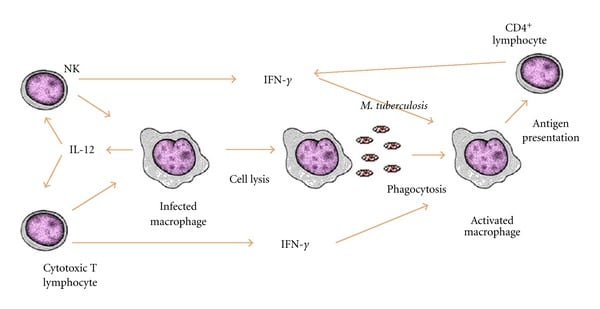Fate of inflammation: There may be four different fates of inflammation - resolution, healing, suppuration (pus and abscess formation) or chronic inflammation.
A) Chronic inflammation: It is seen when acute inflammation persists or when pathogens like Mycobacteria infect the tissues. Macrophages are the most important cell in chronic inflammation. Most tissue macrophages are derived from blood monocytes. Macrophages are activated by cytokines and toxins. Activated macrophages release various enzymes and cytokines which cause tissue necrosis. Other cells important in chronic inflammation are lymphocytes, plasma cells, eosinophils and mast cells. Lymphocytes and macrophages influence each other through cytokines and other mediators. Systemic amyloidosis may occur as a result of chronic inflammation.
i) Chronic granulomatous inflammation: It is a special type of chronic inflammation characterised by granuloma formation. A granuloma is a circumscribed, granule-like lesion made up chiefly of epithelioid cells, multinucleated giant cells and lymphocytes, and may have necrotic areas in the center and fibroblasts and fibrosis at the periphery. Epithelioid cells are the most important component of a granuloma. It is a modified macrophage, but looks more like an epithelial cell with an elongated shape, vesicular nucleus and abundant pale cytoplasm. Multiple epithelioid cells fuse to form the multinucleate giant cells, which may have more than 20 nuclei. There are different types of giant cells - some with nuclei arranged peripherally in a horseshoe pattern called Langhans’ cells or with centrally clustered nuclei called foreign body giant cells. CD4+ or CD8+ lymphocytes are present. Granulomatous inflammation is a type IV hypersensitivity reaction. A characteristic granulomatous inflammation is seen in tuberculosis with central cheese- like or caseous necrosis and appearance of granules called tuberculoma in infected tissues, with the presence of Langhans’ type giant cells.

Mnemonic See A Scratchy TuberKLe. See for Syphilis/ A actinomycosis / Scratchy cat scratch disease/ Tuber Tuberculosis/ Tularaemia // K kleb granulomatis / Le leprosy
Non-infectious causes of granulomatous inflammation are sarcoidosis, berylliosis, vasculitis such as giant cell arteritis, Takayasu’s arteritis, Granulomatosis with polyangiitis (GPA), foreign bodies like talc, sutures, silicosis and Crohn’s disease.

| Cytokine | Role in granuloma |
| IL1 and IL2 | Proliferation of T cells |
| Gamma interferon | Activates macrophages, activation of endothelium to promote CD4+ T cell adhesion, induces TNF secretion by macrophages |
| TNF alpha | Fibroblast proliferation, activates endothelium to secrete prostaglandins and increase adhesion, activates macrophages to kill intracellular pathogens, induction of apoptosis |
| IL 12 | Activation of NK cells and CD8+ T cells, induces gamma interferon production |
| Growth factors (TGF beta, PDGF) | Fibroblast proliferation |
TNF alpha and gamma interferon are essential for the formation and maintenance of a normal granuloma. Overexpression of TNF alpha causes tissue necrosis, cachexia, shock and DIC. Interferons alpha and beta are produced in response to viral infections, alpha by leukocytes and beta by fibroblasts. Gamma interferons are secreted in response to immune and inflammatory stimuli by activated T cells and NK cells.

Initial protective response to M. tuberculosis-Th1 profile.
Sign up for free to take 4 quiz questions on this topic